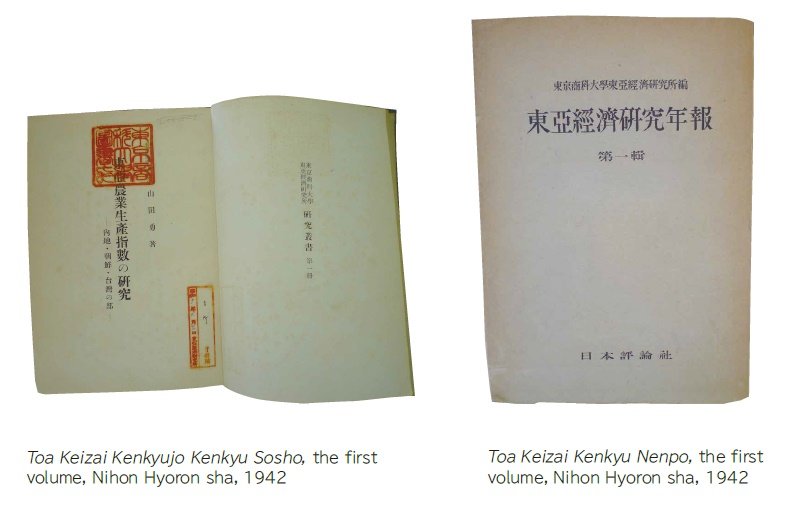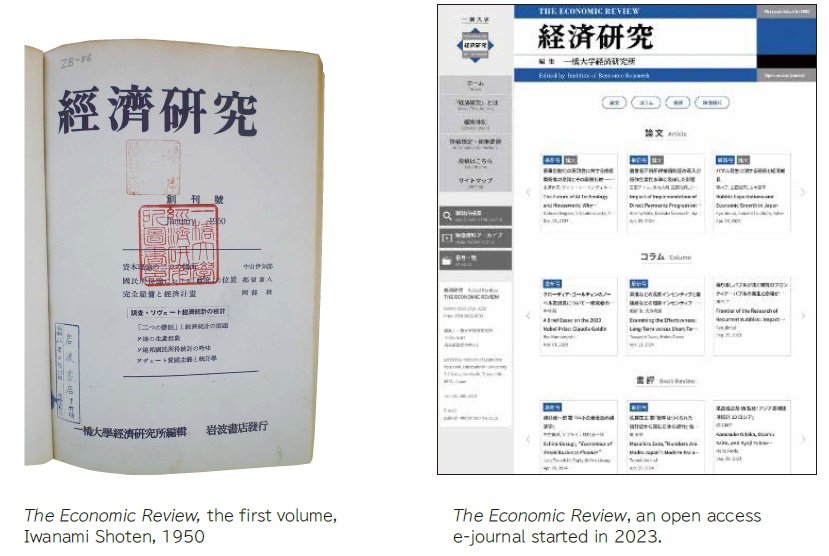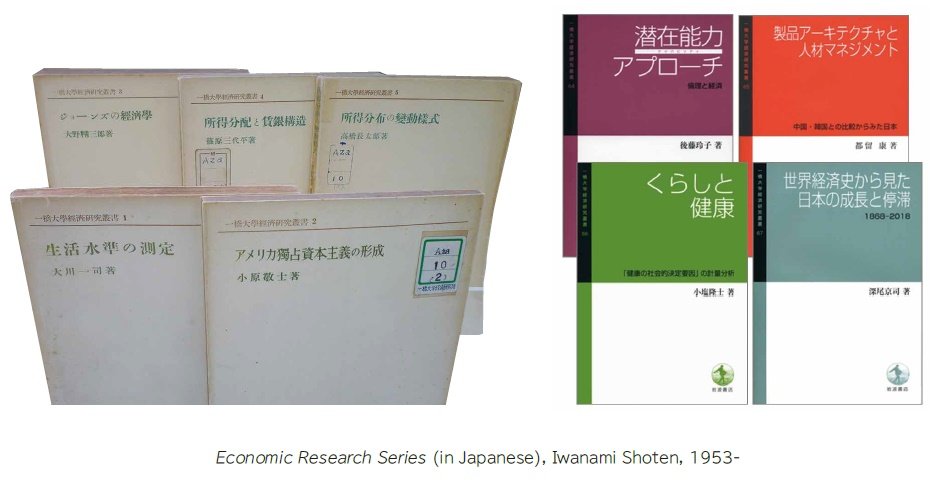The Institute of Economic Research at Hitotsubashi University was originally called the Research Institute of East Asian Economy (Toa Keizai Kenkyujo), which was founded in the library of Tokyo University of Commerce on April 1st, 1940. It was not a government organization at that time, but an institute affiliated with the university and supported by a research grant from Kenkichi Kagami, the president of Tokyo Marine and Fire Insurance. The institute's first head was Teijiro Ueda, president of the Tokyo University of Commerce. Initially, there were three full-time researchers, while the mainstay of the staff were adjunct faculty.
In May 1940, due to Ueda's sudden passing, president Sotaro Takase became the second director of the institute. Takase worked to achieve official recognition for the institute and strengthen its support system, and in November 1940, he formed a group to establish the Tokyo University of Commerce Foundation. By 1942, donations had reached 6 million yen, and the foundation was approved in June. Before this, in February 1942, the government system had come into effect. Japan's first national economic research institute was attached to the university to conduct "comprehensive research on East Asian economies". Planning for the Toa Keizai Kenkyujo Kenkyu Sosho and the Toa Keizai Kenkyu Nenpo proceeded with Kaname Akamatsu as Research Director. Around this time, the Research Division of the Southern Central Military Administration was established in Singapore. Many of its staff members were engaged in research in the South.

With drastic reforms that followed the end of World War II, the Research Institute of East Asia Economies became the Institute of Economic Research. Its research objective was changed to "comprehensive research on global economies". In March 1947, Kinnosuke Otsuka assumed the position of Director and was given the difficult task of reorganizing the institute. In May 1949, with the beginning of the new university system under the National School Establishment Act, the Institute of Economic Research, Hitotsubashi University (henceforth, IER) was established to conduct "comprehensive research on Japanese and world economies". The IER continues to function today, and in November 1949, Shigeto Tsuru became the first director to be elected by the Institute. The following year, in January 1950, the first issue of Keizai Kenkyu (The Economic Review) was published, followed by the Keizai Kenkyu Sosho in August 1953 and the Economic Research Series in 1957, which would become the cornerstones of the Institute.



Dr. Tsuru, the IER's head, explained the plan for reorganization of the institute in Conceptions of the Institute of Economic Research (1949) as follows: "The most important research topic is 'National Income and Reproduction' because it contains theoretical, statistical, empirical, and policy-oriented aspects. It is also advantageous to research this topic collaboratively, so that many researchers would try to involve themselves in this subject. Other research topics will include statistics, econometrics, and the American and Soviet economies. We will also value and pursue research on classical economic theories." Later, the Japanese economy was added as a research subject, and statistical and empirical research on Japanese economy, national income, and processes of economic growth, as well as research on the socialist economies of the USSR and China, became prominent in the academic world. In 1957, the Study Group on National Income Estimates was launched with Kazushi Ohkawa as its leader, with support from the Rockefeller Foundation. All the results of this study group's work were collected in the fourteen volumes of Long-Term Economic Statistics (edited by Kazushi Ohkawa, Miyohei Shinohara, and Mataji Umemura, 1965-1988).

In addition to the five research departments (American Economy, Soviet Economy, National Income and Reproduction, Statistics, and Classical Economics) that were present at the inception of the reorganized IER, a Japanese Economy department was added in the following year. Later, this department was divided into two parts and three more departments -Great Britain and other Commonwealth countries, China and Southeast Asian Economy- were added to make a total of nine departments. In 1961, the institute added the department of International Economic Organization, and the departments of Economic Statistics, Economic System, Monetary Economics, and Contemporary Economic Analysis were subsequently added by 1977 to raise the number of departments to fourteen. However, with the revision of ministerial ordinances, the institute was reduced to five large research sections during 1978-1979: (1) Japanese and Asian Economies; (2) U.S., European and USSR Economies; (3) Contemporary Economies; (4) Comparative Economic Systems; and (5) Economic Systems Analysis. To catch up an academic trends in Economics field in recent years, the institute reorganized the research departments in April, 2015. The new departments are (1) Theories in Economics and Statistics; (2) Economic Measurement and Statistics; (3) Comparative and World Economics; (4) Economic Institutions and Policy; (5) Frontier Sciences in Economics. We hope that our benefit and feature will develop by this fundamental organization reform.
It has been the institute's regular practice to conduct collaborative research and projects with partners outside the institute and its departments. The Center for Economic Institutions (CEI) was established in 2000, and it has contributed toward expanding institute's network of relationships with researchers and institutions both domestically and internationally. The Documentation Centre for the Japanese Economy, established in 1964, became the Research Centre for Information and Statistics of Social Science (RCISSS), with a new section for microdata analysis, as part of the extension and reorganization of the institute in 2002. It provides microdata on government statistics in collaboration with the Statistics Bureau in the Ministry of Internal Affairs and Communications. In 2007, the Center for Intergenerational Studies (CIS) was founded, pursuing the formation of a cutting-edge research base by collaborating with several Ministries. Furthermore, the Research Center for Economic and Social Risks (RCESR) was established in May 2014 for the purpose of conducting empirical analysis of various risks that the Japanese economy may face. This center publishes the SRI-Hitotsubashi Consumer Purchase Index on its website.
Based on the tradition of Long-Term Economic Statistics as the institute's chef d'oeuvre, from 1995 to 2000 the Asian Historical Statistics Project was organized. The Asian Historical Statistics (12 volumes planned), which has been in progress since 1998, is considered an important achievement that should be assumed the intellectual property of the entire economics community. Other projects included "Expanding Usages of Statistical Information" from 1996 to 1999 (supported by Grants-in-Aid for Scientific Research on Priority Areas) and the "Project on Intergenerational Equity" from 2000 to 2005. From 2003 to 2007, two 21st-Century Center of Excellence (COE) programs entitled "Research Unit for Statistical Analysis in the Social Sciences" and "Normative Evaluation and Social Choice of Contemporary Economic Systems" were launched, as well as a JSPS Grant-in-Aid for Creative Scientific Research called "Understanding the Inflation Dynamics in the Japanese Economy" and "Economic Analysis of Intergenerational Issues: Searching for Future Development," were supported by a Grant-in Aid for Specially Promoted Research. These are projects that became possible by the reinforcement of theoretical research, emphasis on policy-oriented perspectives, and promotion of institutional and policy research that comprises the synergistic effects of integrating theoretical and empirical research activities, which were put in place after the publication of the article "History and Future" in the thirtieth-anniversary edition of the Economic Review in 1980. A global COE entitled "Research Unit for Statistical and Empirical Analysis in Social Sciences" was also promoted through the integration and further development of the two COE programs. That international collaboration has now been taken over by the Hitotsubashi Institute for Advanced Study (HIAS). Furthermore, a series of Grants-in-Aid for Scientific Research (S) has also been accepted. These were "Poverty Reduction, Institutions, Markets, and Policies in Developing Countries: Toward a Theory of Comparative Economic Development (PRIMCED)" from 2010-2014 and "Hitotsubashi Project on Real Estate, Financial Crisis, and Economic Dynamics (HIT-REFINED)" from 2013-2017. Also, "Service Sector Productivity in Japan: Determinants and Policies (SSPJ)" from 2016-2020 was adopted. This project aimed to radically reform the way in which productivity is measured in the service industry, and to construct new economics for the service industry based on it. In addition, in 2014-2016, the JSPS Program for Advancing Strategic International Networks to Accelerate the Circulation of Talented Researchers conducted the "International Collaboration for Formulating Trans-Positional Capability Index." A project related on government statistics was conducted in the 2018-2022 period, commissioned as part of the Program for Constructing Data Infrastructure for the Humanities and Social Sciences (Japan Society for the Promotion of Science). Through this, the Data Repository of the Institute of Economic Research, Hitotsubashi University was created as a comprehensive system for promoting the utilization of government statistical data, including aggregated and processed data, by researcher communities in Japan and abroad.

Before the beginning of the 21st century, the IER added new missions, promoting original and cuttingedge research and establishing a joint research unit for members of the research community both within and outside Japan, in addition to continuing its comprehensive economic research on Japan and the world. In 2010, the IER was designated as a "Center for Empirical Analysis on Japanese and Global Economy" by the Joint Usage/Research Center system in the Ministry of Education, Culture, Sports, Science, and Technology; since then, it has been establishing a foundation for a joint usage research center, with joint research projects and facilities as its core. At the end-of-term evaluation from the Ministry of Education, Culture, Sports, Science and Technology for 2010-2015, the center received an overall evaluation of "A: Activities as a center are generally going well, with contributions to related communities, and further results and benefits from joint use and research are anticipated in the future." In the 2018 midterm evaluation and the end-of-term evaluation in 2021, we received the highest score of "S: The center is active in its activities, has achieved notable results and benefits from joint use and research, and has made significant contributions to relevant communities." Therefore, certification was newly granted for the period 2022-2028.